
-
Find the right food for your pet
Take this quiz to see which food may be the best for your furry friend.
Find the right food for your pet
Take this quiz to see which food may be the best for your furry friend.
Featured products
 Adult 7+ Perfect Digestion Chicken, Whole Oats & Brown Rice Recipe Dog Food
Adult 7+ Perfect Digestion Chicken, Whole Oats & Brown Rice Recipe Dog FoodScience Diet's breakthrough nutrition supports ultimate digestive well-being & healthy microbiome for dogs age 7+
Shop Now Small & Mini Savory Stew with Chicken & Vegetables Dog Food
Small & Mini Savory Stew with Chicken & Vegetables Dog FoodA delicious complement to the nutrition of Science Diet Small & Mini 7+ dog food
Shop Now Adult Healthy Cuisine Roasted Chicken, Carrots & Spinach Stew Dog Food
Adult Healthy Cuisine Roasted Chicken, Carrots & Spinach Stew Dog FoodDelicious roasted chicken paired with tender vegetables in a succulent stew
Shop NowFeatured products
 Adult 7+ Tender Tuna Dinner Cat Food
Adult 7+ Tender Tuna Dinner Cat FoodWith delicious chunks in a decadent gravy
Shop Now Adult Savory Entrée Can Variety Pack Cat Food
Adult Savory Entrée Can Variety Pack Cat FoodPrecisely balanced nutrition with the delicious taste of savory minced chicken to help fuel the energy needs of cats during the prime of their life
Shop Now Adult 7+ Senior Vitality Chicken & Vegetable Stew Cat Food
Adult 7+ Senior Vitality Chicken & Vegetable Stew Cat FoodImproves Everyday Ability to Get Up & Go
Shop Now -
Dog
- Dog Tips & Articles
-
Health Category
- Weight
- Food & Environmental Sensitivities
- Urinary
- Digestive
- Joint
- Kidney
-
Life Stage
- Puppy Nutrition
- Adult Nutrition
- Senior Nutrition
Cat
- Cat Tips & Articles
-
Health Category
- Weight
- Skin & Food Sensitivities
- Urinary
- Digestive
- Kidney
-
Life Stage
- Kitten Nutrition
- Adult Nutrition
Featured articles
 Do Dogs and Cats have Belly Buttons?
Do Dogs and Cats have Belly Buttons?Learn whether cats & dogs have belly buttons like humans, what the function is, and if there are any health concerns associated with it.
Read More Why Are Dogs and Cats So Cute?
Why Are Dogs and Cats So Cute?If waggy puppy dog tails and furry kitten yawns make you swoon, you're not alone. Why are cats so cute? And, dogs too! Let's find out!
Read More Does My Pet Hate Me?
Does My Pet Hate Me?Learn tips for bonding with your pet if you've ever thought, 'My dog doesn't like me, or 'Why do I have a standoffish cat?'
Read More -


Every cat parent knows that their feline friend enjoys a good stalking and pounce every now and then. Many indoor cat owners often ask, "Why do cats pounce if they don't actually need to hunt for food?" The pounce is actually part of a full sequence of activities that cats have a natural instinct to perform. Understanding each part of this predatory dance sequence can help cat owners have more meaningful playtime with their kitties.
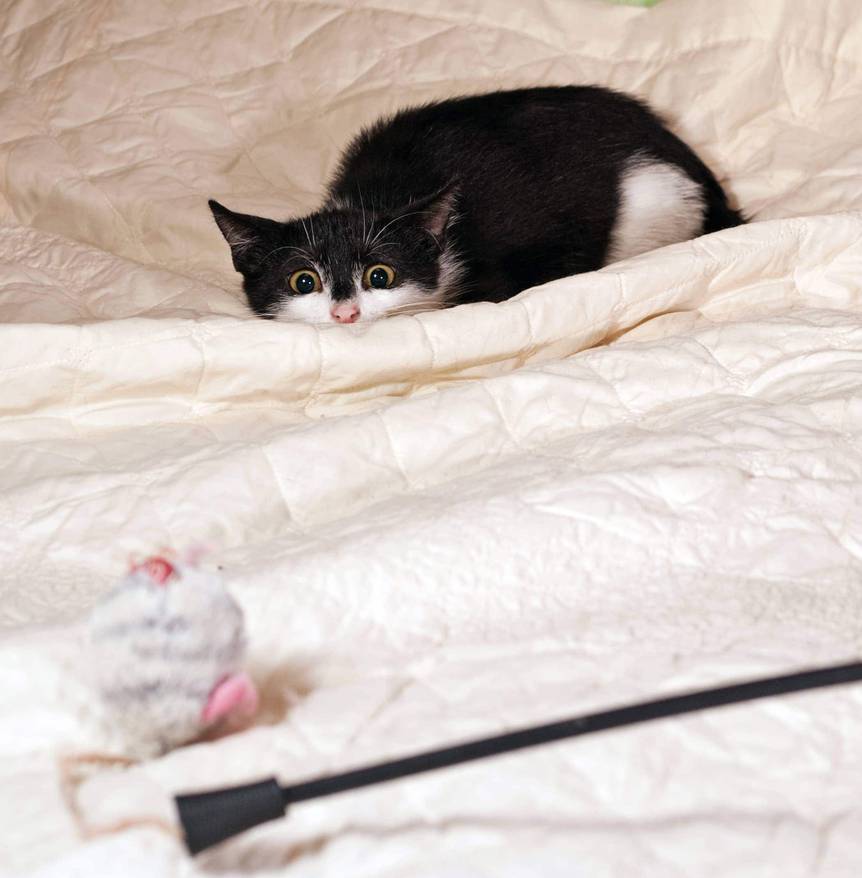
Serious Stalkers
Cats have a natural instinct to hunt and catch prey. The University of California, Santa Cruz reports that research on mountain lions shows that these large wild cats do not have much endurance and instead store up energy and exert just the right amount depending on the size of their prey. Domesticated cats are very similar. They will sit and stare or slowly move to a better position to stalk their prey. Cats usually aren't looking to chase prey for long periods of time. Instead, they want to position themselves in a good spot and exert energy on a solid pounce.
Even when cats know the prey is not real or alive, they still go through the predatory dance sequence, and they love every part of it. That is why cats will enjoy a fake mouse toy set in a spot rather than a throw-and-chase game like you might have a with a dog and his ball. The mouse toy can sit still and your cat will begin with the stalk and then prepare for the pounce. Each movement of is crucial for a successful capture.
Preparing for the Pounce
Kittens can master the pounce as early as nine weeks old. Even older cats still enjoy a stalk and pounce every once in a while. Whether the cat is young or old, the predatory dance sequence is pretty consistent and cats rarely pounce without first settling into a spot and preparing their back legs. After stalking and finding prey, a cat may focus her stare and start wiggling her butt before the big leap occurs. Although this butt wiggle can seem really funny, it is actually a crucial step. Wiggling and adjusting their back end helps ground them to get a good leap. Cats will size up their target and adjust the force needed to have a solid pounce and take down the prey. Larger prey may require more wiggling or longer shaking in order to get the energy and balance needed to land the leap and pounce on the prey.


Tasty Tips
Post-Pounce Behaviors
Why do cats pounce and then seem to play with their prey and bat it around for a while? Although it may seem like your cat is just playing around with the toy, cats have an instinct to kill the prey with a bite to the neck. Since cats use a lot of energy on the pounce, they need to make the kill as quickly and with the least amount of effort as possible. This means they need their prey to be in the right position. That's why you'll see your kitty bat or toss her prey around prior to biting it.
Since cat pouncing is a natural instinct, finding toys and playing games that encourage pouncing helps your cat hone her technique. So the next time you and your cat play together, be sure to watch for the different steps and be amazed at the process she goes through to catch her prey. Not to mention that this is great exercise for your indoor cat, as well as a bonding experience for you both.


Chrissie Klinger is an educator, writer and mother of two children, three dogs and three cats. Her dog Jake loves sitting on her lap every chance he gets! She enjoys living an active and eco-friendly lifestyle in rural Pennsylvania.
Related products
Related articles
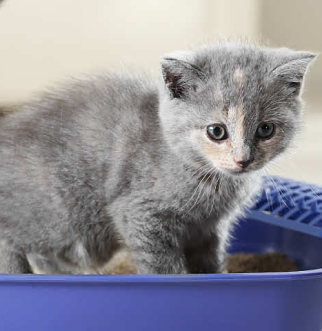
Cats are naturally very clean and chances are your kitten will already have learned how to use the litter box from her mother before she comes to live with you.
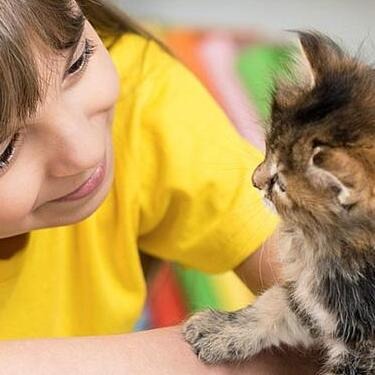
Discover how to train your cat, starting with very basic first steps that both reward good behavior and discourage the bad.
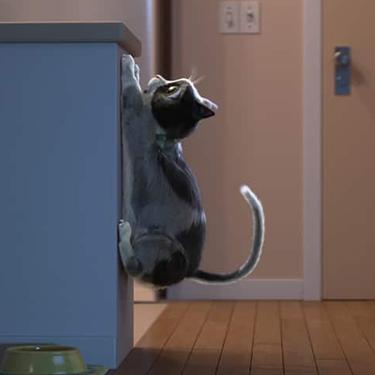
What is the best food for an overweight cat? Learn all about weight control food for cats, including what's in it and how it works.
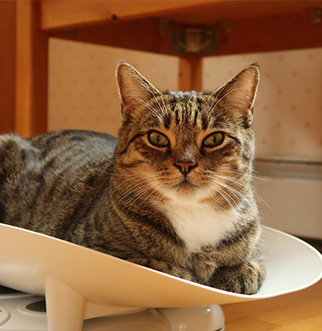
How do you get a cat to lose weight? Learn all about cat foods for weight loss, including how to choose weight control cat food and exercise tips.

Put your cat on a diet without them knowing
Our low calorie formula helps you control your cat's weight. It's packed with high-quality protein for building lean muscles, and made with purposeful ingredients for a flavorful, nutritious meal. Clinically proven antioxidants, Vitamin C+E, help promote a healthy immune system.
Put your cat on a diet without them knowing
Our low calorie formula helps you control your cat's weight. It's packed with high-quality protein for building lean muscles, and made with purposeful ingredients for a flavorful, nutritious meal. Clinically proven antioxidants, Vitamin C+E, help promote a healthy immune system.

